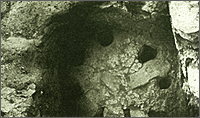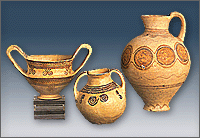 |
||
Middle Helladic pottery is the most well known art of the Middle Bronze Age on the Greek Mainland and the one that gives the most complete picture of the Middle Helladic technological achievements. Its diffusion in the Aegean region constitutes the most sensitive indicator of product trading and the extent of trade during this period. Although the Middle Bronze Age on Mainland Greece is characterized by a general retrogression in the arts, ceramic production presents new, remarkable artistic trends and significant technological innovations. The most important innovation is the widespread use of the potter's wheel which first appeared in the Aegean about 2300 BC, during the transition from the Early Helladic II to the Early Helladic III period. In the Middle Bronze Age more and more wheel-driven vases were made while a technologically advanced rotating wheel which contributed to the rapid manufacture of vases with thin walls and complex shapes was put into use. |
 |
|
|
Ceramic kiln at Kolonna on Aegina.
|
||
|
One of the most typical features of Middle Helladic pottery is the existence of many local workshops with distinguishable styles. Thus, the fine pottery of the Peloponnese is easily discerned from that of central Greece while very often differences between the production of smaller regions, such as the Argolid and the southwestern Peloponnese, are identified. The pottery of the workshop of Aigina is distinct. Its products were exported at an unusual for that period extent. But the greatest part of the ceramics were transported at a small distance from their place of production. The limits of the greater distribution of ceramics usually corresponded to the natural frontiers of the greater geographical regions. However, larger quantities of imported ceramics are indicated in the biggest urban centres and the coastal areas. The two basic ceramic wares wares are the Minyan and the Matt-painted. The Minyan was diffused, at least in the Argolid, from the Early Helladic II period (2300-2000 BC) whereas the Matt-painted appeared during the transition from the Early to the Middle Bronze Age. |
||
|
Kantharos, amphoriskos and
jug with Matt-painted decoration from the Grave Circle B at Mycenae. |
||
|
The two pottery categories which are distinguished in smaller ones remained the main ceramic styles in the whole Middle Helladic period. The quality of the Minyan and Matt-painted ceramics was constantly improved and more fine vases were made while their initially restricted typology was enrichened with new shapes which corresponded to the demands of the buyers. In some regions their production continued through the early periods of the Late Bronze Age. Alongside the regional pottery wares other styles from the Cyclades and Crete appear on the Greek Mainland from time to time. The relative chronology of the Middle Helladic pottery and its division in sub-periods is formed on the basis of these imported products, as there is no reliable evidence on Mainland Greece of absolute chronology. In the beginning of the Middle Helladic III period, about 1700 BC, and as vases were still made with earlier techniques, the quality of ceramics was considerably improved and a series of new shapes appears. At the same time, pottery is heavily influenced by the Cycladic pottery and indirectly by Minoan ceramics. Middle Helladic pottery adopts decorative motifs and vase shapes from the art of these two insular cultures and mainland potters combine them creatively with the elements of the regional Middle Helladic tradition. The variety of new shapes, as well as the new trend for vases of a smaller size seem to be attributed to the more frequent cultural influence of the more advanced regions of the Aegean and it may imply the changes in drinking habits or the turn to another kind of nutrition. From this time onward pottery approaches little by little the creation of the Mycenaean ceramics which seem to have resulted from the fusion of regional Middle Helladic elements with those of the Minoan and Cycladic art. |
